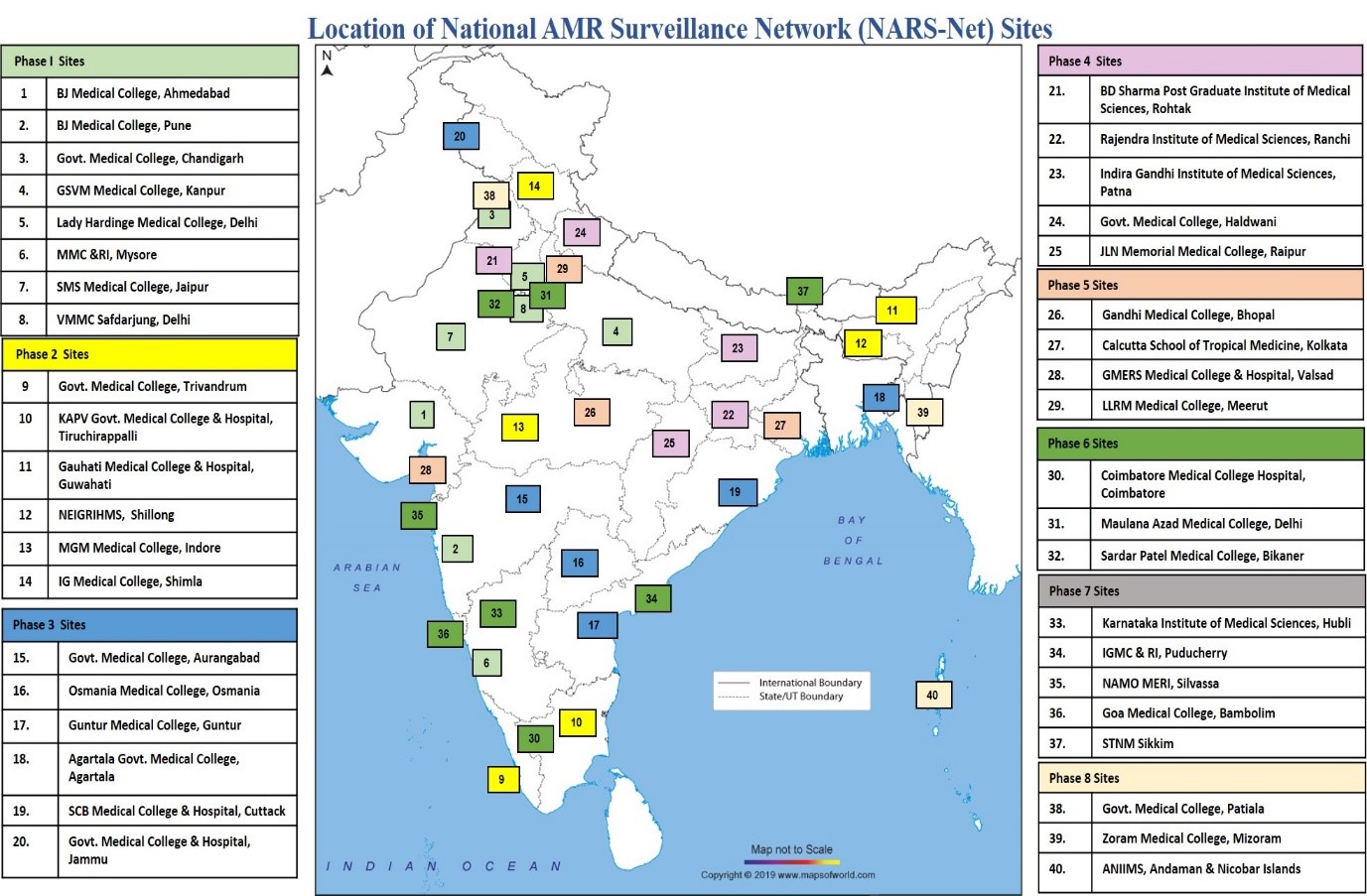Indian government adopting western country policy to crub antibiotic resistance

National Centre for Disease Control
Directorate General of Health Services. Ministry of Health & Family Welfare Government of India


National Centre for Disease Control
Directorate General of Health Services, Ministry of Health & Family Welfare
Government of India

National Centre for Disease Control
Directorate General of Health Services. Ministry of Health & Family Welfare Government of India


Home › National Programme on AMR Containment
National Programme on AMR Containment
Antimicrobial resistance is a growing public health problem. Resistance has emerged even to newer & more potent antimicrobial agents like Carbapenems. The rapid spread of multi-drug resistant bacteria and the lack of new antibiotics to treat infections caused by these organisms pose a rapidly increasing threat to human health which urgently needs to be tackled if we are to contain the problem and prevent untreatable illness from becoming a reality. India has given due cognizance to the problem of Antimicrobial resistance (AMR) and to tackle this issue, Government of India launched a “National Programme on AMR Containment” during the 12th five-year plan (2012-2017) which is being coordinated by NCDC. The network of labs is being expanded in a phased manner and currently includes 35 state medical college labs in 26 States/UTs.
The main objectives of this programme are
- 1Establish a laboratory-based AMR surveillance system in the country to generate quality data on antimicrobial resistance
- 2Carry out surveillance of antimicrobial usage in different health care settings
- 3Strengthen infection control practices and promote rational use of antimicrobials through Antimicrobial stewardship activities
- 4Generate awareness amongst health care providers and community on antimicrobial resistance and rational use of antimicrobials.
Activities carried out under the programme
AMR Surveillance
- 1BJMC Pune, Maharashtra
- 2BJMC Ahmedabad, Gujarat
- 3GSVM Medical college Kanpur, UP
- 4GMCH Chandigarh
- 5SMS Medical College Jaipur, Rajasthan
- 6LHMC, Delhi
- 7VMMC and Safdarjung Hospital, Delhi
- 8MMC & RI Mysore, Karnataka
- 9KAPV Government Medical College, Trichy, Tamil Nadu
- 10Government Medical College, Thiruvanathapuram, Kerala
- 11Guwahati Medical college, Guwahati, Assam
- 12Mahatma Gandhi Memorial Medical college, Indore, MP
- 13NEIGRIHMs, Shillong, Meghalaya
- 14IGMC, Shimla, HP
- 15Medical College, Jammu
- 16Medical College, Aurangabad, Maharashtra
- 17Osmania General Hospital & Osmania Medical College, Hyderabad, Telangana
- 18SCB Medical College Hospital, Cuttack, Odisha
- 19Agartala Govt. Medical College & GBP Hospital
- 20Guntur Medical College & Govt. General Hospital, Andhra Pradesh
- 21Jawaharlal Nehru Memorial Medical College, Raipur, Chattisgarh
- 22Rajendra Institute of Medical Sciences, Ranchi, Jharkhand
- 23B D Sharma PGIMS Rohtak, Haryana
- 24Indira Gandhi Institute of Medical Sciences, Sheikhpura, Patna, Bihar
- 25Medical College, Haldwani, Uttarakhand
- 26Gandhi Medical College, Bhopal, Madhya Pradesh
- 27Calcutta School of Tropical Medicine, Kolkata, West Bengal
- 28LLRM Govt. Medical College, Merrut, Uttar Pradesh
- 29GMERS Medical College, Valsad, Gujarat
- 30Coimbatore Medical College & Hospital (CMCH), Coimbatore, Tamil Nadu
- 31Maulana Azad Medical College & Associated Hospitals, Delhi
- 32Sardar Patel Medical College, Bikaner, Rajasthan
- 33Karnataka Institute of Medical Sciences, Hubbali, Karnataka
- 34Indira Gandhi Medical College & Research Institute, Puducherry
- 35NAMO Medical College & Research Institute, Silvassa, UT of Dadra & Nagar Haveli and Daman & Diu
- 36Goa Medical College and Hospital, Goa
- 37STNM Hospital, Gangtok, Sikkim
- 38Government Medical College, Patiala, Punjab
- 39Zoram Medical College, Mizoram
- 40Andaman and Nicobar Institute of Medical Sciences, Port Blair

National Treatment Guidelines
A common unified National Treatment Guidelines for antimicrobial use in infectious diseases has been released and uploaded on the website at: National Treatment Guidelines for Antimicrobial Use in Infectious Diseases. It can serve as a guide to all the hospitals to formulate their own guidelines on basis of which physicians will be trained.
Infection Prevention & Control guidelines and surveillance of Healthcare associated infections
“National Guidelines for Infection Prevention and Control in Healthcare facilities” have been developed with support from WHO and have been disseminated to various stakeholders and also unloaded on NCDC website at National-Guidelines-for-IPC-in-HCF For surveillance of Healthcare associated infections, sentinel sites under the National Programme on AMR Containment are joining the ICMR-AIIMS Healthcare Associated Infections (HAI) surveillance network in a phased manner. For more details on ICMR-AIIMS HAI surveillance network may refer to https://www.haisindia.com
IEC Activities
Material for IEC has been developed and its dissemination is under process. In addition, various IEC activities are conducted/supported round the year including quiz competition in schools, public lectures in academic Institutions and radio programmes, participation in Health fairs etc.
Review meetings, trainings and workshops
The network labs are provided training on WHONET software and onsite support through site visits. All the labs are trained for Micro broth dilution testing for colistin and vancomycin. Annual meetings are conducted to review the working of the network labs under the programme.
Strengthening Laboratory capacity for AMR detection
During onsite visits, the lab capacity is assessed and hand holding is done for strengthening Internal Quality Control and Proficiency testing in these labs. 1% resistant strains are to be submitted every quarter by the sites for confirmation to NCDC. Most labs under the programme are enrolled onto the IAMM EQAS programme. Back








